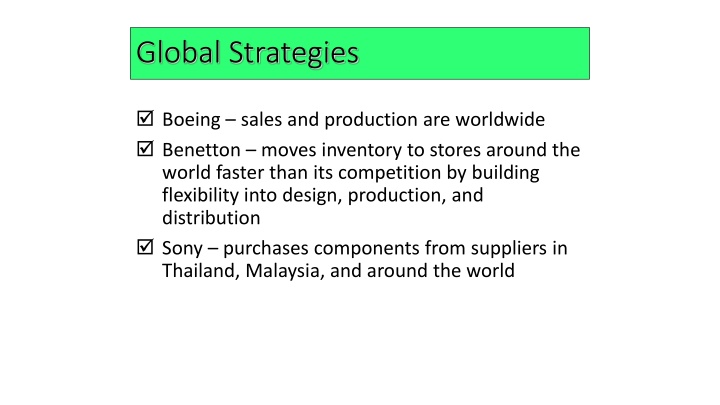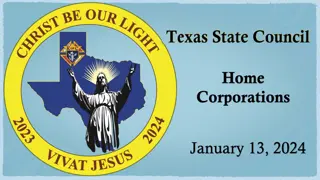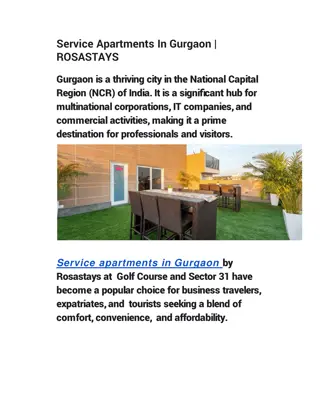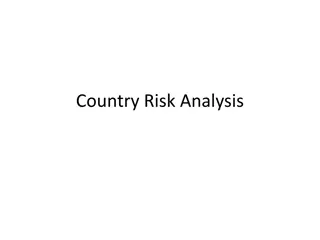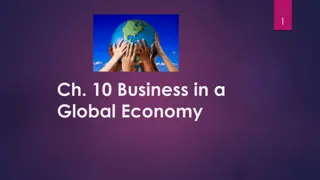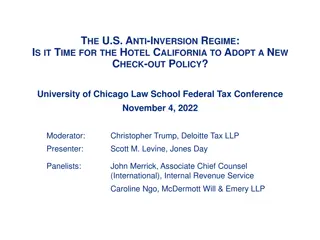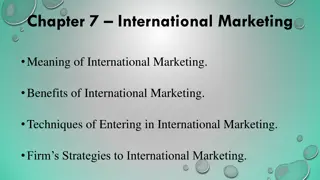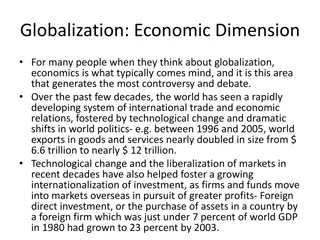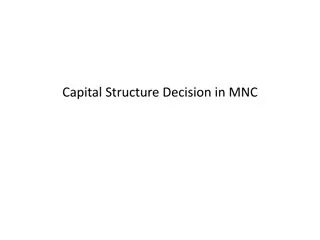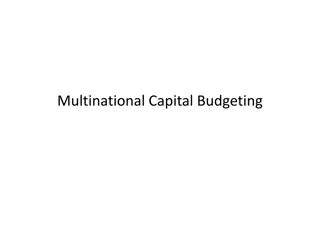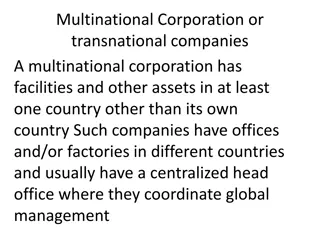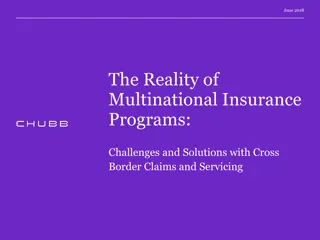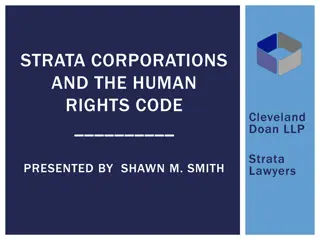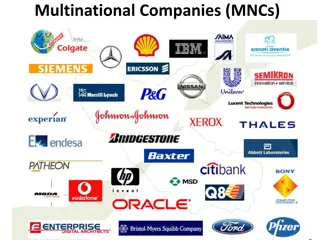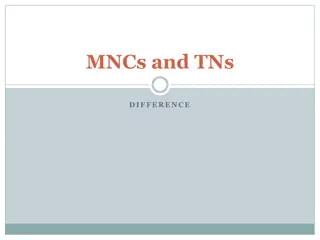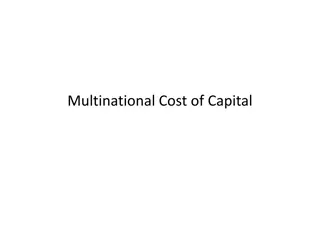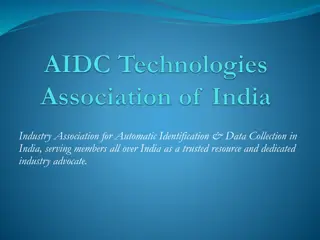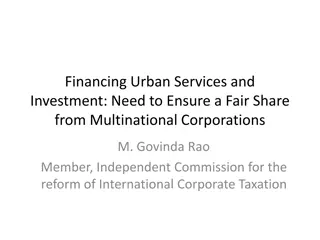Global Strategies in Multinational Corporations
Boeing, Benetton, Sony, Volvo, and Haier exemplify global strategies by expanding sales, production, and workforce across countries. Multinational corporations like Citicorp, Colgate-Palmolive, Dow Chemical, Gillette, Honda, and IBM have significant foreign sales, assets, and workforce. The involvement of various countries in the supply chain for Boeing's 787 aircraft showcases the interconnectedness of global trade and production.
Download Presentation

Please find below an Image/Link to download the presentation.
The content on the website is provided AS IS for your information and personal use only. It may not be sold, licensed, or shared on other websites without obtaining consent from the author.If you encounter any issues during the download, it is possible that the publisher has removed the file from their server.
You are allowed to download the files provided on this website for personal or commercial use, subject to the condition that they are used lawfully. All files are the property of their respective owners.
The content on the website is provided AS IS for your information and personal use only. It may not be sold, licensed, or shared on other websites without obtaining consent from the author.
E N D
Presentation Transcript
Global Strategies Boeing sales and production are worldwide Benetton moves inventory to stores around the world faster than its competition by building flexibility into design, production, and distribution Sony purchases components from suppliers in Thailand, Malaysia, and around the world
Global Strategies Volvo considered a Swedish company but it is controlled by an American company, Ford. The current Volvo S40 is built in Belgium and shares its platform with the Mazda 3 built in Japan and the Ford Focus built in Europe. Haier A Chinese company, produces compact refrigerators (it has one-third of the US market) and wine cabinets (it has half of the US market) in South Carolina
Some Multinational Corporations % Sales Outside Home Country % Assets Outside Home Country Company Home Country % Foreign Workforce Citicorp Colgate- Palmolive Dow Chemical Gillette Honda IBM USA USA 34 72 46 63 NA NA USA 60 50 NA USA Japan USA 62 63 57 53 36 47 NA NA 51
Some Multinational Corporations % Sales Outside Home Country % Assets Outside Home Country Company Home Country % Foreign Workforce ICI Nestle Philips Electronics Siemens Unilever Britain Switzerland Netherlands 78 98 94 50 95 85 NA 97 82 Germany Britain & Netherlands 51 95 NA 70 38 64
Boeing Suppliers (787) Firm Dassault Messier-Bugatti Thales Diehl FR-HiTemp Smiths Aerospace Country France France France Germany UK UK Component Design and PLM software Landing gear Electrical power conversion system and integrated standby flight display Interior lighting Fuel pumps and valves Central computer system
Boeing Suppliers (787) Firm BAE SYSTEMS Alenia Aeronautics Toray Industries Fuji Heavy Industries Kawasaki Heavy Industries Country UK Italy Japan Japan Component Electronics Upper center fuselage & horizontal stabilizer Carbon fiber for wing and tail units Center wing box Japan Forward fuselage, fixed section of wing, landing gear well
Boeing Suppliers (787) Firm Teijin Seiki Mitsubishi Heavy Industries Chengdu Aircraft Group Hafei Aviation Country Japan Japan Component Hydraulic actuators Wing box China Rudder China Parts
Reasons to Globalize Reasons to Globalize Tangible Reasons Reduce costs (labor, taxes, tariffs, etc.) Improve supply chain Provide better goods and services Understand markets Learn to improve operations Attract and retain global talent Intangible Reasons Figure 2.1
Reduce Costs Foreign locations with lower wage rates can lower direct and indirect costs Maquiladoras World Trade Organization (WTC) North American Free Trade Agreement (NAFTA) APEC, SEATO, MERCOSUR European Union (EU)
Improve the Supply Chain Locating facilities closer to unique resources Auto design to California Athletic shoe production to China Perfume manufacturing in France
Provide Better Goods and Services Objective and subjective characteristics of goods and services On-time deliveries Cultural variables Improved customer service
Understand Markets Interacting with foreign customer and suppliers can lead to new opportunities Cell phone design from Europe Cell phone fads from Japan Extend the product life cycle
Learn to Improve Operations Remain open to the free flow of ideas General Motors partnered with a Japanese auto manufacturer to learn Scandinavian design ideas have been used to improve equipment design and layout
Attract and Retain Global Talent Offer better employment opportunities Better growth opportunities and insulation against unemployment Relocate unneeded personnel to more prosperous locations Incentives for people who like to travel
Cultural and Ethical Issues Cultures can be quite different Attitudes can be quite different towards Punctuality Lunch breaks Environment Intellectual property Thievery Bribery Child labor
You May Wish To Consider Work ethic Tax rates Inflation Availability of raw materials Interest rates Population Number of miles of highway Phone system National literacy rate Rate of innovation Rate of technology change Number of skilled workers Political stability Product liability laws Export restrictions Variations in language
Match Product & Parent Braun Household Appliances Firestone Tires Godiva Chocolate Haagen-Dazs Ice Cream Jaguar Autos MGM Movies Lamborghini Autos Alpo Petfoods 1. Volkswagen 2. Bridgestone 3. Campbell Soup 4. Ford Motor Company 5. Gillette 6. Nestl 7. Pillsbury 8. Sony
Match Product & Parent Braun Household Appliances Firestone Tires Godiva Chocolate Haagen-Dazs Ice Cream Jaguar Autos MGM Movies Lamborghini Autos Alpo Petfoods 1. Volkswagen 2. Bridgestone 3. Campbell Soup 4. Ford Motor Company 5. Gillette 6. Nestl 7. Pillsbury 8. Sony
Match Product & Country Braun Household Appliances Firestone Tires Godiva Chocolate Haagen-Dazs Ice Cream Jaguar Autos MGM Movies Lamborghini Autos Alpo Petfoods 1. Great Britain 2. Germany 3. Japan 4. United States 5. Switzerland
Match Product & Country Braun Household Appliances Firestone Tires Godiva Chocolate Haagen-Dazs Ice Cream Jaguar Autos MGM Movies Lamborghini Autos Alpo Petfoods 1. Great Britain 2. Germany 3. Japan 4. United States 5. Switzerland
Developing Missions and Strategies Mission statements tell an organization where it is going The Strategy tells the organization how to get there
Mission Mission - where are you going? Organization s purpose for being Answers What do we provide society? Provides boundaries and focus
FedEx FedEx is committed to our People-Service-Profit philosophy. We will produce outstanding financial returns by providing total reliable, competitively superior, global air-ground transportation of high priority goods and documents that require rapid, time-certain delivery. Equally important, positive control of each package will be maintained using real time electronic tracking and tracing systems. A complete record of each shipment and delivery will be presented with our request for payment. We will be helpful, courteous, and professional to each other and the public. We will strive to have a completely satisfied customer at the end of each transaction. Figure 2.2
Merck The mission of Merck is to provide society with superior products and services - innovations and solutions that improve the quality of life and satisfy customer needs - to provide employees with meaningful work and advancement opportunities and investors with a superior rate of return Figure 2.2
Hard Rock Caf Our Mission: To spread the spirit of Rock n Roll by delivering an exceptional entertainment and dining experience. We are committed to being an important, contributing member of our community and offering the Hard Rock family a fun, healthy, and nurturing work environment while ensuring our long-term success. Figure 2.2
Arnold Palmer Hospital Arnold Palmer Hospital is a healing environment providing family-centered care with compassion, comfort and respect when it matters the most. Figure 2.2
Factors Affecting Mission Philosophy and Values Profitability and Growth Environment Mission Customers Public Image Benefit to Society
Strategic Process Organization s Mission Functional Area Missions Finance/ Accounting Marketing Operations
Strategy Action plan to achieve mission Functional areas have strategies Strategies exploit opportunities and strengths, neutralize threats, and avoid weaknesses
Strategies for Competitive Advantage Differentiation better, or at least different Cost leadership cheaper Quick response more responsive
Competing on Differentiation Uniqueness can go beyond both the physical characteristics and service attributes to encompass everything that impacts customer s perception of value Safeskin gloves leading edge products Walt Disney Magic Kingdom experience differentiation Hard Rock Cafe theme experience
Competing on Cost Provide the maximum value as perceived by customer. Does not imply low quality. Southwest Airlines secondary airports, no frills service, efficient utilization of equipment Wal-Mart small overheads, shrinkage, distribution costs Franz Colruyt no bags, low light, no music, doors on freezers
Competing on Response Flexibility is matching market changes in design innovation and volumes Institutionalization at Hewlett-Packard Reliability is meeting schedules German machine industry Timeliness is quickness in design, production, and delivery Johnson Electric, Bennigan s, Motorola
OMs Contribution to Strategy Operations Decisions Specific Strategy Used Competitive Advantage Examples Product FLEXIBILITY Sony s constant innovation of new products ....Design HP s ability to follow the printer market Volume Quality Process Southwest Airlines No-frills service .. ..LOW COST Location Pizza Hut s five-minute guarantee at lunchtime .. .. ..Speed Federal Express s absolutely, positively on time .. .Dependability DELIVERY Differentiation (Better) Layout Human resource Response (Faster) Motorola s automotive products ignition systems ......Conformance Motorola s pagers .. .Performance QUALITY Supply-chain Cost leadership (Cheaper) Inventory IBM s after-sale service on mainframe computers ....AFTER-SALE SERVICE Scheduling Fidelity Security s broad line of mutual funds .BROAD PRODUCT LINE Maintenance Figure 2.4
10 Strategic OM Decisions Human resource and job design Supply-chain management Inventory Scheduling Maintenance Goods and service design Quality Process and capacity design Location selection Layout design
Goods and Services and the 10 OM Decisions Operations Decisions Goods and service design Quality Goods Services Product is usually tangible Product is not tangible Many objective standards Many subjective standards Process and capacity design Customers not involved Customer may be directly involved Capacity must match demand Table 2.1
Goods and Services and the 10 OM Decisions Operations Decisions Location selection Goods Services Near raw materials and labor Near customers Layout design Production efficiency Enhances product and production Human resources and job design Technical skills, constant labor standards, output based wages Interact with customers, labor standards vary Table 2.1
Goods and Services and the 10 OM Decisions Operations Decisions Supply- chain mgmt Goods Services Relationship critical to final product Raw materials, work-in-process, and finished goods may be held Level schedules possible Important, but may not be critical Cannot be stored Inventory Scheduling Meet immediate customer demand Table 2.1
Goods and Services and the 10 OM Decisions Operations Decisions Maintenance Often preventive and takes place at production site Goods Services Often repair and takes place at customer s site Table 2.1
Process Design Process-focused JOB SHOPS (Print shop, emergency room, machine shop, fine dining Mass Customization Customization at high Volume (Dell Computer s PC) High Repetitive (modular) focus ASSEMBLY LINE (Cars, appliances, TVs, fast-food restaurants) Variety of Products Moderate Product focused CONTINUOUS (steel, beer, paper, bread, institutional kitchen) Low Low Moderate Volume High
Managing Global Service Operations Probably requires a different perspective on: Capacity planning Location planning Facilities design and layout Scheduling
Characteristics of High ROI Firms High quality product High capacity utilization High operating effectiveness Low investment intensity Low direct cost per unit From the PIMS program of the Strategic Planning Institute
Strategic Options to Gain a Competitive Advantage 28% - Operations Management 18% - Marketing/distribution 17% - Momentum/name recognition 16% - Quality/service 14% - Good management 4% - Financial resources 3% - Other
Elements of Operations Management Strategy Low-cost product Product-line breadth Technical superiority Product characteristics/differentiation Continuing product innovation Low-price/high-value offerings Efficient, flexible operations adaptable to consumers Engineering research development Location Scheduling
Preconditions One must understand: Strengths and weaknesses of competitors and possible new entrants into the market Current and prospective environmental, technological, legal, and economic issues The product life cycle Resources available within the firm and within the OM function Integration of OM strategy with company s strategy and with other functional areas
Dynamics of Strategic Change Changes within the organization Personnel Finance Technology Product life Changes in the environment
Product Life Cycle Introduction Growth Maturity Decline Best period to increase market share Practical to change price or quality image Poor time to change image, price, or quality Cost control critical Company Strategy/Issues R&D engineering is critical Strengthen niche Competitive costs become critical Defend market position Fax machines CD-ROM Internet Drive-through restaurants Color printers Sales 3 1/2 Floppy disks Flat-screen monitors DVD Figure 2.5
Product Life Cycle Introduction Growth Maturity Decline Product design and development critical Forecasting critical Standardization Little product differentiation Product and process reliability Less rapid product changes more minor changes Cost minimization Frequent product and process design changes OM Strategy/Issues Competitive product improvements and options Optimum capacity Overcapacity in the industry Increasing stability of process Short production runs Increase capacity Prune line to eliminate items not returning good margin Shift toward product focus Long production runs High production costs Enhance distribution Product improvement and cost cutting Limited models Reduce capacity Attention to quality Figure 2.5
Strategy Development and Implementation Identify critical success factors Build and staff the organization Integrate OM with other activities The operations manager s job is to implement an OM strategy, provide competitive advantage, and increase productivity
Strategy Development Process Environmental Analysis Identify the strengths, weaknesses, opportunities, and threats. Understand the environment, customers, industry, and competitors. Determine Corporate Mission State the reason for the firm s existence and identify the value it wishes to create. Form a Strategy Build a competitive advantage, such as low price, design, or volume flexibility, quality, quick delivery, dependability, after- sale service, broad product lines. Figure 2.6
